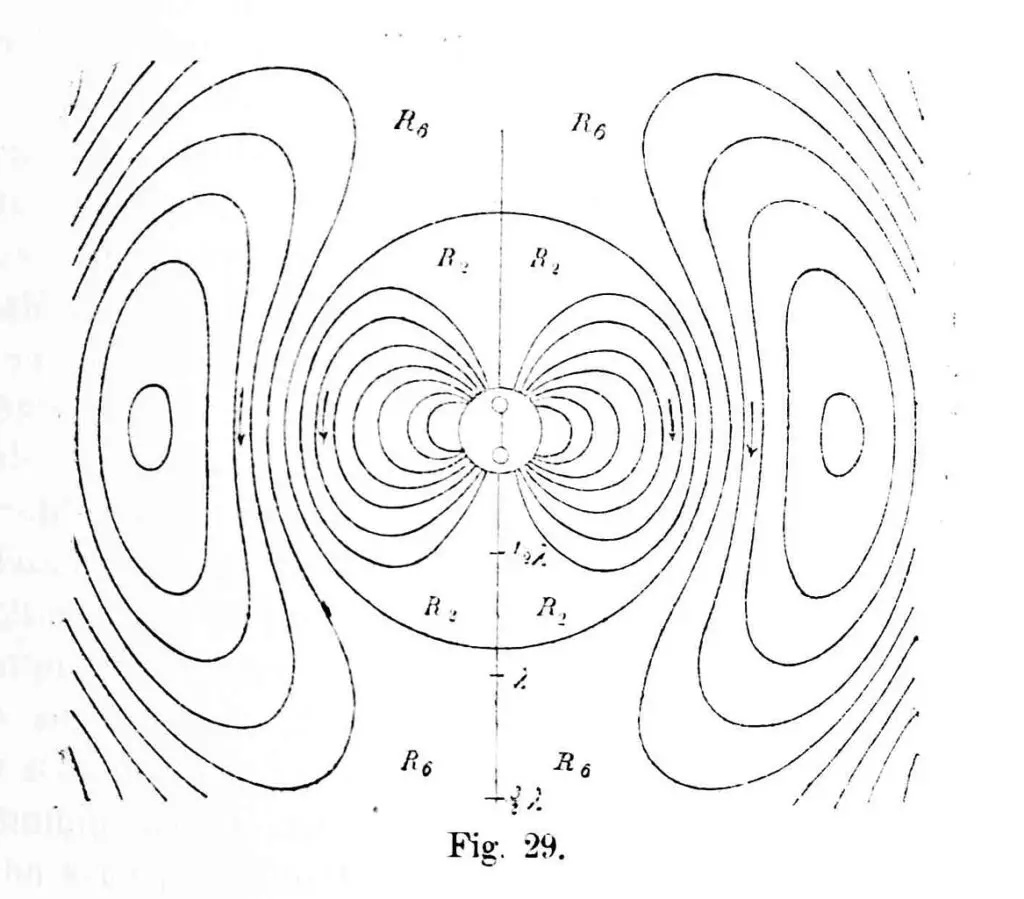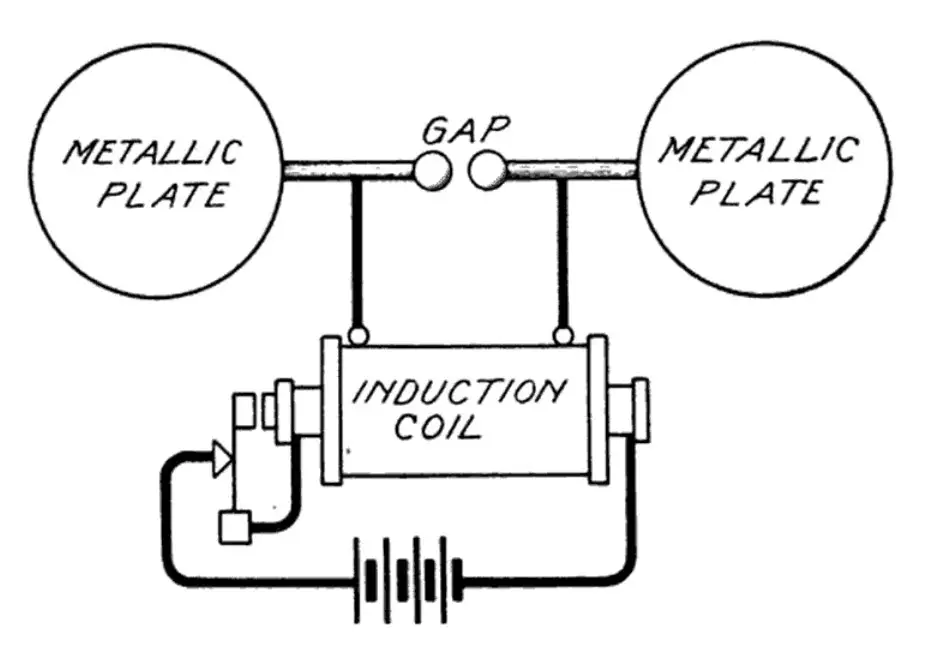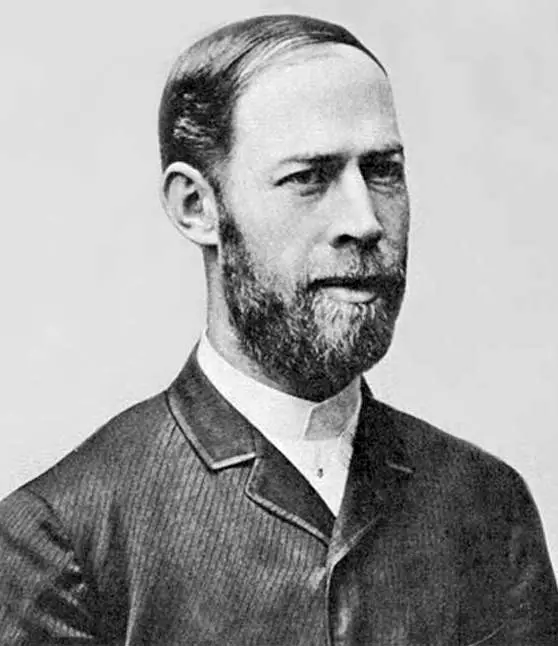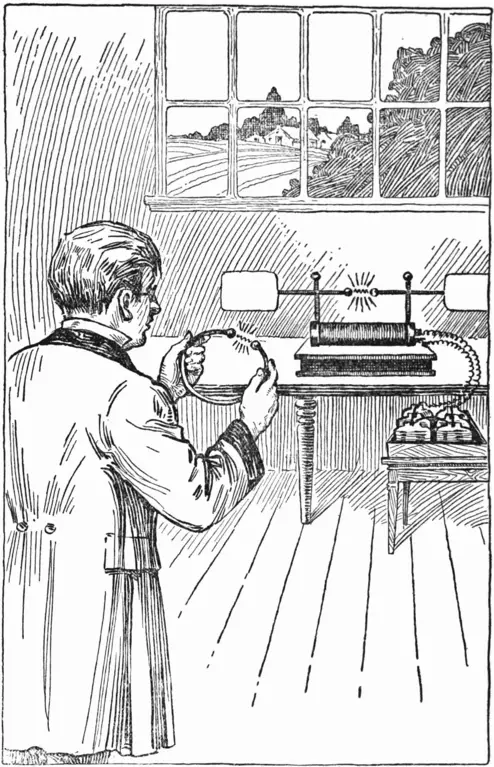In 1886, Heinrich Hertz embarked on a series of experiments that would irrevocably alter the course of scientific understanding and technological development. His work not only demonstrated the existence of electromagnetic waves but also validated the theoretical predictions made by James Clerk Maxwell two decades earlier. Maxwell’s equations, a set of differential equations formulated in the mid-19th century, had proposed the existence of electromagnetic waves—oscillations of electric and magnetic fields traveling through space. However, these groundbreaking ideas remained in the realm of theory due to the lack of empirical evidence to support them.
The scientific context before Hertz’s experiments was one of skepticism and anticipation. Maxwell’s theories suggested that light itself was an electromagnetic wave, implying a universal mechanism for the propagation of light, electricity, and magnetism. Yet, the notion of invisible waves traveling through the ether without a medium was contentious, challenging the prevailing scientific paradigms of the time. Hertz, through his meticulous experiments, sought to bridge the gap between Maxwell’s theoretical universe and the tangible, observable world. His success would not only confirm Maxwell’s equations as one of the pillars of modern physics but also lay the foundational principles for the development of radio technology and, by extension, amateur radio.
- Maxwell’s Electromagnetic Theory
- Heinrich Hertz’s Early Life and Academic Background
- Early Life and Education
- Path to Electromagnetic Theory
- Key Influences and Mentors
- The Experiments of 1886
- Experimental Setup
- Significance of the Spark-Gap Transmitter and Ring Detector
- Measuring Velocity and Wavelength
- Technical Breakdown: Understanding Hertz’s Contributions
- Principles Utilized in Hertz’s Experiments
- Resonance
- Induction
- Wave Propagation
- Hertz’s Findings and the Electromagnetic Spectrum
- Support for Maxwell’s Theories
- Existence of Radio Waves
- Concept of the Electromagnetic Spectrum
- Impact on the Field of Electromagnetism and Physics
- Scientific Community’s Reception
- Facilitating Advances in Electromagnetism and Physics
- Stimulating Theoretical Advances
- Inspiring Technological Innovations
- Quantum Mechanics
- Educational Impact
- Heinrich Hertz’s Legacy in Amateur Radio
- Direct Relevance to Amateur Radio Development
- Validating the Theoretical Foundation for Wireless Communication
- Influence on Early Radio Pioneers and the Evolution of Amateur Radio
- Conclusion
- Further Reading
- Engage and Share Your Insights
Maxwell’s Electromagnetic Theory
James Clerk Maxwell, a Scottish physicist, revolutionized the understanding of electromagnetic phenomena in the mid-19th century with his formulation of the electromagnetic theory. Maxwell’s equations, a set of four partial differential equations, described how electric fields and magnetic fields interact and predicted the existence of electromagnetic waves—fluctuations of these fields propagating through space at the speed of light. Maxwell proposed that light itself was an electromagnetic wave, a radical idea that unified the theories of electricity, magnetism, and optics into a single theoretical framework.
Maxwell’s equations are succinctly expressed as follows:
- Gauss’s Law for Electricity (
): This equation describes how electric charges produce an electric field.
- Gauss’s Law for Magnetism (
): This states that there are no magnetic monopoles; instead, magnetic field lines form closed loops.
- Faraday’s Law of Induction (
): This law shows how a changing magnetic field induces an electric field.
- Ampere’s Law with Maxwell’s addition (
): This illustrates that magnetic fields are generated by electric currents and changes in electric fields.
Despite the elegance and potential of Maxwell’s theory to unify several branches of physics, it faced considerable skepticism. In the late 19th century, the physical sciences were dominated by mechanical models, and the idea of “fields” propagating through a seemingly empty space (the ether) was difficult for many to accept. Without direct empirical evidence of electromagnetic waves, Maxwell’s theory remained a beautiful but unverified framework.
The skepticism wasn’t just philosophical; practical implications were at stake. If Maxwell’s equations were correct, they would not only explain known phenomena like light and magnetism but also predict new forms of waves that could be harnessed for communication. This potential was enormous but, in the absence of concrete proof, remained speculative. The scientific community awaited tangible evidence to move Maxwell’s electromagnetic theory from the realm of theoretical physics into the toolset of engineering and technology, setting the stage for Heinrich Hertz’s pivotal experiments.
Heinrich Hertz’s Early Life and Academic Background
Early Life and Education
Heinrich Rudolf Hertz was born on February 22, 1857, in Hamburg, Germany. From a young age, Hertz exhibited a profound interest in the sciences, alongside talents in engineering and languages. His education began in the realms of classical languages; however, his passion for physics and mathematics quickly took precedence. Hertz pursued his studies in engineering at the Dresden Technical University before moving to Munich and then to Berlin, where he studied physics under the tutelage of Hermann von Helmholtz, one of the most prominent scientists of the time.
Path to Electromagnetic Theory
Hertz’s academic journey was characterized by a rigorous exploration of both theoretical and experimental physics. Under Helmholtz’s guidance, he delved into the study of electromagnetism, a field that was rapidly evolving due to Maxwell’s recent theoretical advancements. Hertz’s doctoral dissertation, completed in 1880 at the University of Berlin, focused on the rotation of polarized light in moving media, a topic that bridged optics and electromagnetism and hinted at his future contributions to the field.
Key Influences and Mentors
Hermann von Helmholtz was instrumental in shaping Hertz’s scientific career. Helmholtz not only provided Hertz with a strong foundation in theoretical physics but also emphasized the importance of experimental evidence in validating theoretical models. This mentorship ingrained in Hertz a profound appreciation for the interplay between theory and experiment, guiding his later work in proving the existence of electromagnetic waves. Helmholtz’s encouragement and the broader scientific environment of the time, which was ripe with questions about the nature of electromagnetic phenomena, set Hertz on his path to making groundbreaking discoveries.
The Experiments of 1886
Experimental Setup
In 1886, Heinrich Hertz constructed a series of experiments that conclusively demonstrated the existence of electromagnetic waves, thus providing the empirical evidence needed to validate James Clerk Maxwell’s theoretical predictions. The centerpiece of Hertz’s experimental setup was the spark-gap transmitter, which consisted of two brass spheres separated by a small gap. When a high voltage was applied across the spheres, a spark would jump the gap, creating oscillating electric currents that, according to Maxwell’s theory, should emit electromagnetic waves.
To detect these waves, Hertz used a simple yet ingenious device: a ring detector, also known as a Hertzian dipole, which was essentially a loop of wire with a small gap. When electromagnetic waves generated by the spark-gap transmitter encountered the loop, they induced a secondary spark across the gap in the detector. By placing the detector at various distances and orientations relative to the transmitter, Hertz observed the sparks, thereby directly demonstrating the wave nature of electromagnetism.
Significance of the Spark-Gap Transmitter and Ring Detector
The use of the spark-gap transmitter was pivotal for generating high-frequency electromagnetic waves, a necessity for validating Maxwell’s predictions. The simplicity and effectiveness of the spark-gap allowed Hertz to generate repeatable and observable electromagnetic phenomena in a controlled laboratory setting. Similarly, the ring detector’s simplicity belied its effectiveness in revealing the presence and properties of electromagnetic waves. Together, these tools provided a direct, observable link between electrical currents and electromagnetic fields, bridging theory and experiment.
Measuring Velocity and Wavelength
Hertz varied his experiments to measure key properties of the electromagnetic waves, including their velocity and wavelength. By adjusting the distance between the transmitter and the detector, he observed the formation of standing waves, from which he could calculate the wavelength of the electromagnetic emissions. Furthermore, Hertz used rotating mirrors and the principles of interference to measure the velocity of the waves. His findings showed that electromagnetic waves travel at the speed of light, thus supporting Maxwell’s assertion that light itself is an electromagnetic wave. These measurements not only validated Maxwell’s equations but also proved that electromagnetic waves exhibit wave-particle duality, a fundamental concept in physics.
The experiments conducted by Hertz in 1886 were a monumental achievement in physics, providing the crucial link between theoretical electromagnetism and practical application. This breakthrough laid the groundwork for the development of radio technology and opened new avenues for research in physics and engineering, showcasing the transformative power of experimental evidence in advancing scientific knowledge.
Technical Breakdown: Understanding Hertz’s Contributions
Principles Utilized in Hertz’s Experiments
Hertz’s experiments were grounded in several fundamental principles of physics, which not only facilitated his discovery of electromagnetic waves but also helped validate and expand upon Maxwell’s theories.
Resonance
Hertz’s experiments made ingenious use of the principle of resonance, wherein the spark-gap transmitter and ring detector were tuned to the same natural frequency. This tuning allowed for the efficient transfer of energy from the transmitter to the detector, maximizing the detectability of the electromagnetic waves. Resonance was crucial in demonstrating that electromagnetic waves could be generated and detected over distances, a core tenet of wave theory.
Induction
The detection mechanism employed by Hertz relied on electromagnetic induction, whereby the electromagnetic waves produced by the transmitter induced an electric current in the ring detector. This current then manifested as a spark across the gap of the detector, providing observable evidence of the wave’s presence and properties.
Wave Propagation
Through his experiments, Hertz was able to demonstrate key aspects of wave propagation, including reflection, refraction, and polarization. By observing how electromagnetic waves behaved when encountering various materials and obstacles, Hertz offered empirical support for Maxwell’s assertion that light and electromagnetic waves shared the same fundamental properties.

Hertz’s Findings and the Electromagnetic Spectrum
Hertz’s work provided critical insights into the nature of electromagnetic waves and their place within the broader electromagnetic spectrum.
Support for Maxwell’s Theories
By demonstrating the existence of electromagnetic waves and measuring their velocity to be the speed of light, Hertz’s experiments offered tangible proof of Maxwell’s equations. This evidence supported Maxwell’s unification of light, electricity, and magnetism into a single theory of electromagnetism.
Existence of Radio Waves
One of the most significant outcomes of Hertz’s experiments was the discovery of radio waves, a type of electromagnetic wave with longer wavelengths than visible light. Hertz showed that these waves could be produced, detected, and manipulated using electrical apparatus, laying the foundation for the field of wireless communication.
Concept of the Electromagnetic Spectrum
Hertz’s findings underscored the concept of the electromagnetic spectrum, a continuum of electromagnetic waves ranging from radio waves at the longest wavelengths to gamma rays at the shortest. This spectrum encompasses all known electromagnetic radiation, including visible light, and highlights the universal nature of electromagnetic phenomena.
Hertz’s technical contributions extended far beyond his immediate discoveries. By providing empirical validation for Maxwell’s theoretical framework, he set the stage for the rapid development of electromagnetic technology, including radio, television, and radar. Moreover, Hertz’s work inspired subsequent generations of physicists and engineers to explore the vast potential of electromagnetic waves, fundamentally shaping the modern technological landscape.
Impact on the Field of Electromagnetism and Physics
Scientific Community’s Reception
Upon unveiling his experiments, Heinrich Hertz ignited a reevaluation of electromagnetic theory within the scientific community. Skeptics of Maxwell’s theories were confronted with undeniable evidence of electromagnetic waves, prompting a widespread reassessment of the understanding of light, electricity, and magnetism. The confirmation of electromagnetic waves expanded the theoretical and experimental foundations of physics, encouraging a more unified view of natural forces.
Facilitating Advances in Electromagnetism and Physics
Hertz’s work had immediate and far-reaching consequences for the scientific exploration of electromagnetism and the development of new technologies:
Stimulating Theoretical Advances
The empirical evidence provided by Hertz’s experiments invigorated theoretical research in electromagnetism. Physicists were now equipped with a concrete framework to explore electromagnetic phenomena, leading to a deeper understanding of wave propagation, the nature of light, and the electromagnetic spectrum.
Inspiring Technological Innovations
Though Hertz could not predict the future applications of his discovery, his work set the stage for rapid advancements in technology. The early 20th century saw the practical application of electromagnetic waves in radio, laying the groundwork for all wireless communications technology that followed.
Quantum Mechanics
The experimental validation of wave properties in electromagnetic phenomena contributed to the early discussions that would eventually lead to quantum mechanics. Hertz’s findings played a part in shaping the quantum theory, particularly in understanding the wave-particle duality of light.
Educational Impact
Hertz’s experiments became a cornerstone of physics education, demonstrating the importance of empirical evidence in validating theoretical science. This not only influenced how physics was taught but also underscored the critical role of experimentation in the scientific method.
Hertz’s confirmation of electromagnetic waves thus served as a catalyst for a series of developments that transcended his initial findings. The breadth of research and technological innovation that followed his discoveries is a testament to the fundamental shift his work represented in the understanding of natural phenomena.

Heinrich Hertz’s Legacy in Amateur Radio
Direct Relevance to Amateur Radio Development
Heinrich Hertz’s discoveries hold a foundational place in the annals of amateur radio, marking the dawn of the era of wireless communication. By demonstrating the existence and properties of radio waves, Hertz provided the empirical bedrock upon which the entire structure of amateur radio was built. His work showed that information could be transmitted through space without the need for physical connections, a revolutionary concept that would eventually allow amateur radio operators to communicate across continents and oceans.
Validating the Theoretical Foundation for Wireless Communication
The practical demonstration of electromagnetic waves by Hertz validated James Clerk Maxwell’s theoretical predictions, giving early radio pioneers the confidence to experiment with wireless transmission. This validation was crucial; without it, the theoretical underpinnings of radio technology might have remained a scientific curiosity rather than becoming a cornerstone of modern communication.
The early experiments and innovations in radio technology, including the development of spark-gap transmitters, were directly inspired by Hertz’s work. These devices, which were the first to enable practical wireless communication, operated on principles that Hertz had demonstrated in his laboratory. As technology progressed, the evolution of amateur radio closely mirrored the advancements in understanding and harnessing electromagnetic waves, with Hertz’s experiments serving as the starting point.
Influence on Early Radio Pioneers and the Evolution of Amateur Radio
Hertz’s discoveries had a profound impact on early radio pioneers such as Guglielmo Marconi, who was able to take the theoretical knowledge and experimental evidence of electromagnetic waves and turn them into a practical communication system. This system would become the basis for both commercial radio broadcasting and amateur radio. The amateur radio community, in turn, has played a significant role in advancing the technology and science of radio communication, experimenting with new modes of transmission, exploring the limits of radio wave propagation, and even contributing to emergency communication infrastructure.
In essence, Heinrich Hertz’s legacy in amateur radio is one of empowerment and inspiration. His work not only laid the scientific groundwork for the field but also exemplified the spirit of curiosity and experimentation that drives amateur radio enthusiasts. By proving that the airwaves were a viable medium for transmitting information, Hertz opened up a new realm of possibility for communication, exploration, and community building that amateur radio operators continue to expand upon today.
Conclusion
Heinrich Hertz’s pioneering work in the late 19th century fundamentally transformed our understanding of electromagnetism and laid the groundwork for the development of amateur radio, among many other technologies. By empirically demonstrating the existence of electromagnetic waves, Hertz not only validated James Clerk Maxwell’s theoretical predictions but also opened the door to the practical exploitation of radio waves for communication. His experiments, characterized by remarkable ingenuity and precision, bridged the gap between theoretical physics and technological application, paving the way for the wireless world we live in today.
The impact of Hertz’s discoveries on the field of amateur radio cannot be overstated. His work provided the scientific foundation upon which the hobby and science of amateur radio were built. It inspired generations of enthusiasts and professionals alike to explore the airwaves, leading to innovations in communication technology, advancements in global connectivity, and the development of lifesaving emergency communication systems. Amateur radio operators, in their pursuit of understanding and mastering radio wave propagation, continue to embody the spirit of experimentation and discovery that Hertz exemplified.
Reflecting on Hertz’s contributions highlights the critical role of empirical evidence in the advancement of scientific understanding and technology. His ability to transform abstract equations into observable phenomena underscored the importance of experimentation in validating and extending theoretical models. This interplay between theory and experiment remains at the heart of scientific inquiry and technological innovation, driving progress in physics, engineering, and beyond.
In conclusion, Heinrich Hertz’s legacy extends far beyond his own time, influencing countless fields and forever changing the way we communicate. His work serves as a powerful reminder of the transformative potential of scientific curiosity, rigorous experimentation, and the relentless pursuit of knowledge.
Further Reading
For those interested in diving deeper into the life and groundbreaking work of Heinrich Hertz, as well as the broader implications of his discovery of radio waves, here are some valuable resources for further reading:
- James Clerk Maxwell and the Prediction of Radio Waves on Ham Radio Academy
- Famous Scientists offers an insightful overview of how Heinrich Hertz discovered radio waves, highlighting the context and significance of his experiments.
- Encyclopædia Britannica provides a comprehensive biography of Heinrich Hertz, detailing his life, academic background, and the experiments that confirmed the existence of electromagnetic waves.
- Magnet Academy – National MagLab delves into Hertz’s discovery of radio waves, underscoring its role in confirming James Clerk Maxwell’s electromagnetic theory and paving the way for advances in communication technology.
- NASA – Science@NASA discusses the significance of radio waves, from Hertz’s proof of their existence to their astronomical applications and how they’ve revolutionized our understanding of the universe.
- WHYY shares a historical perspective on Heinrich Hertz and his experiments, providing context to his motivations and the impact of his work on the field of electromagnetism and beyond.
- Julian T. Rubin highlights Hertz’s experiments and their role in the discovery of radio waves, including a technical breakdown of his experimental setup and the implications of his findings.
- KIT (Karlsruhe Institute of Technology) commemorates 125 years since the discovery of electromagnetic waves, reflecting on the enduring significance of Hertz’s work in the field of radio frequency technology and its applications.
- All About Circuits explores Heinrich Hertz’s contributions to modern RF (radio frequency) understanding, from his academic career to the experiments that proved the existence of electromagnetic waves.
These resources offer a rich tapestry of information, from Hertz’s personal journey to the profound scientific and technological legacy of his experiments. Whether you’re interested in the historical context, the technical details of his discoveries, or the impact on modern science and technology, these readings provide a thorough exploration of a pivotal moment in the history of physics and communication.
Engage and Share Your Insights
Inspired by Heinrich Hertz’s groundbreaking work and its profound impact on amateur radio? We’d love to hear your thoughts, experiences, and how this historical journey influences your approach to amateur radio today. Leave a comment below to share your insights, questions, or any innovative experiments you’ve been working on in the spirit of Hertz’s legacy. Let’s continue the conversation and keep the tradition of curiosity and discovery alive in the amateur radio community.



🦮MOg🎙📻💖